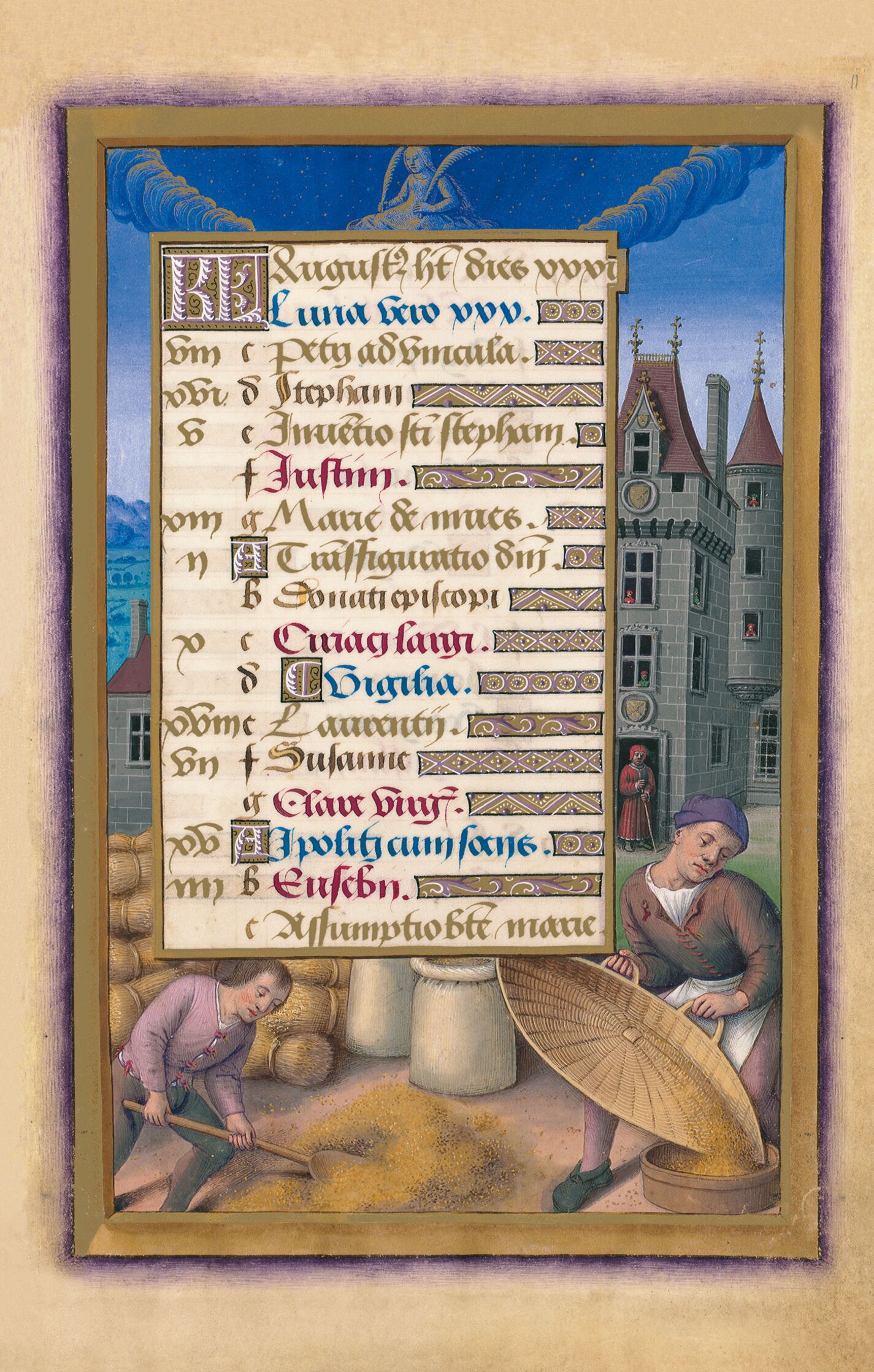Virgo is depicted as a long-haired maiden wearing a gown sitting directly on the floor, or rather on top of the frame around the text of the calendar, with a palm leaf in each hand: a corruption of the ears of corn appearing in the representations of Classical times. Underneath, in the patio of a large mansion, being watched by a man in the doorway and several people at the window, next to tied sheaves and large sacks of white cloth containing clean grains of cereal, are two men sorting the grain: the man on the left with a wooden spade is busy winnowing, i.e. using this implement to throw the grain into the air, whilst the man on the right is shown emptying a riddle – after separating the wheat from the chaff – into a cylindrical, wooden recipient. This task was always done outdoors on a fine and preferably slightly windy day. Its position in August is due to the influence of northern iconographic cycles, although in regions with temperate climes it was recommended that grain be stored on the stalk in a barn to finish ripening, before being threshed and then winnowed three months after mowing. However, unlike Flemish calendars from the Late Middle Ages, in the Great Hours of Anne of Brittany winnowing was done immediately after the harvest. This task does not appear in medieval iconography until the 13th century. The earliest, extant representations of a riddle appear in the Landgrave Psalter (Stuttgart, Württembergische Landesbibliothek, HB II. 24, f. 6r), painted in Thuringia in c. 1215, and in a stained-glass window in Lausanne cathedral made in c. 1235 by Pierre d’Arras and his atelier. These images did not proliferate until the 15th century, and by the end of this century the threshing typical of the month of August was finally replaced by sorting in many manuscripts in the Tours area. It would seem, judging by iconographic sources, that the riddle was used above all in northern France and Flanders. The texts, however, confirm its use also in southern France. As regards winnowing, the earliest graphic testimonies date from the late 13th and early 14th centuries in the Italian area; indeed, winnowing with a spade is depicted particularly in works of art from the south.

Virgo is depicted as a long-haired maiden wearing a gown sitting directly on the floor, or rather on top of the frame around the text of the calendar, with a palm leaf in each hand: a corruption of the ears of corn appearing in the representations of Classical times. Underneath, in the patio of a large mansion, being watched by a man in the doorway and several people at the window, next to tied sheaves and large sacks of white cloth containing clean grains of cereal, are two men sorting the grain: the man on the left with a wooden spade is busy winnowing, i.e. using this implement to throw the grain into the air, whilst the man on the right is shown emptying a riddle – after separating the wheat from the chaff – into a cylindrical, wooden recipient. This task was always done outdoors on a fine and preferably slightly windy day. Its position in August is due to the influence of northern iconographic cycles, although in regions with temperate climes it was recommended that grain be stored on the stalk in a barn to finish ripening, before being threshed and then winnowed three months after mowing. However, unlike Flemish calendars from the Late Middle Ages, in the Great Hours of Anne of Brittany winnowing was done immediately after the harvest. This task does not appear in medieval iconography until the 13th century. The earliest, extant representations of a riddle appear in the Landgrave Psalter (Stuttgart, Württembergische Landesbibliothek, HB II. 24, f. 6r), painted in Thuringia in c. 1215, and in a stained-glass window in Lausanne cathedral made in c. 1235 by Pierre d’Arras and his atelier. These images did not proliferate until the 15th century, and by the end of this century the threshing typical of the month of August was finally replaced by sorting in many manuscripts in the Tours area. It would seem, judging by iconographic sources, that the riddle was used above all in northern France and Flanders. The texts, however, confirm its use also in southern France. As regards winnowing, the earliest graphic testimonies date from the late 13th and early 14th centuries in the Italian area; indeed, winnowing with a spade is depicted particularly in works of art from the south.